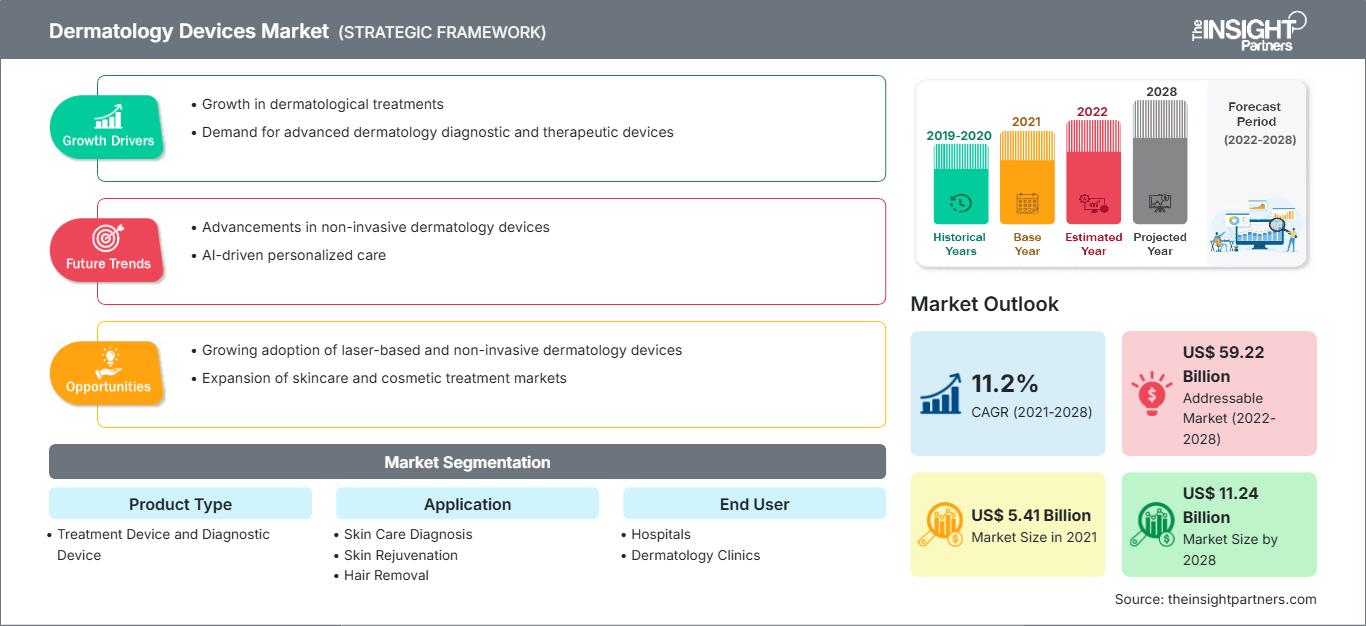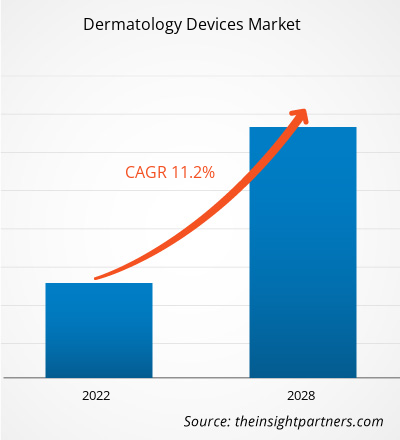Le marché mondial des dispositifs dermatologiques était évalué à 5 408,57 millions de dollars américains en 2021 ; sa croissance devrait atteindre un TCAC de 11,2 % entre 2022 et 2028.
Le rapport met en évidence les tendances dominantes du marché des dispositifs dermatologiques et les facteurs qui stimulent sa croissance. La dermatologie implique l'utilisation d'une large gamme de dispositifs médicaux pour la réalisation de procédures dermatologiques esthétiques et médicales. Les dispositifs dermatologiques aident au diagnostic et au traitement de diverses affections cutanées, telles que le cancer de la peau et le psoriasis. Ils peuvent également être utilisés pour la cryochirurgie, la thérapie photodynamique, la chirurgie micrographique de Mohs, l'électrodessiccation et le curetage. La Food and Drug Administration (FDA) joue un rôle essentiel dans la réglementation, l'approbation et la surveillance post-commercialisation de ces dispositifs, garantissant ainsi leur sécurité et leur efficacité.
Le rapport offre des informations et une analyse approfondie du marché mondial des dispositifs dermatologiques, en mettant l'accent sur divers paramètres, notamment les tendances du marché, les avancées technologiques, la dynamique du marché et l'analyse du paysage concurrentiel des principaux acteurs. Il inclut également l'impact de la pandémie de COVID-19 sur le marché dans toutes les régions. La COVID-19 a eu un impact globalement mitigé sur le marché mondial des dispositifs dermatologiques. Les systèmes de santé ont été surchargés dans le contexte de cette crise sanitaire mondiale, et la prestation de soins médicaux à tous les patients est devenue un défi majeur dans de nombreuses régions. De plus, avec la progression de la pandémie de COVID-19, les entreprises de dispositifs médicaux ont rencontré des difficultés pour gérer leurs opérations. De nombreux fabricants de dispositifs dermatologiques ayant des activités commerciales aux États-Unis ont été affectés par l'épidémie généralisée. Cependant, après que les restrictions liées à la pandémie ont été assouplies en réponse à la diminution du nombre de cas, le nombre de procédures esthétiques effectuées par les dermatologues est revenu à des niveaux normaux, car les hôpitaux ont commencé à reprendre les procédures électives, propulsant ainsi la demande d'appareils dermatologiques.
Vous bénéficierez d’une personnalisation sur n’importe quel rapport - gratuitement - y compris des parties de ce rapport, ou une analyse au niveau du pays, un pack de données Excel, ainsi que de profiter d’offres exceptionnelles et de réductions pour les start-ups et les universités
Marché des dispositifs dermatologiques: Perspectives stratégiques

- Obtenez les principales tendances clés du marché de ce rapport.Cet échantillon GRATUIT comprendra une analyse de données, allant des tendances du marché aux estimations et prévisions.
Marché des dispositifs dermatologiques - Informations géographiques
Le marché mondial des dispositifs dermatologiques est segmenté géographiquement en Amérique du Nord (États-Unis, Canada et Mexique), Europe (Allemagne, Royaume-Uni, France, Italie, Espagne et reste de l'Europe), Asie-Pacifique (Chine, Japon, Inde, Corée du Sud, Australie et reste de l'APAC), Amérique du Sud et centrale (Brésil, Argentine et reste de l'Amérique du Sud et centrale) et Moyen-Orient et Afrique (Arabie saoudite, Afrique du Sud, Émirats arabes unis et reste du Moyen-Orient et de l'Afrique).
Informations sur le marché
Prévalence croissante du cancer et des troubles cutanés
Selon le rapport de l'American Academy of Dermatology Association (AAD), le cancer de la peau est le type de cancer le plus répandu aux États-Unis. Pour mémoire, on estime que plus de 9 500 personnes aux États-Unis reçoivent un diagnostic de cancer de la peau chaque jour. La majorité des cancers de la peau sont des cancers cutanés non mélaniques (CPNM), touchant plus de 3 millions d'Américains chaque année. Parmi ces derniers, les femmes présentent les taux d'incidence les plus élevés pour les CPNM, avec une augmentation chez les jeunes. Le coût annuel du traitement des cancers de la peau aux États-Unis est estimé à 1,8 milliard de dollars américains, 4,8 milliards de dollars américains pour les CPNM et 3,3 milliards de dollars américains pour le mélanome. De plus, le rapport de Frontiers SA indique que la prévalence du cancer de la peau est une tendance mondiale. La biopsie cutanée et l'évaluation histopathologique sont essentielles pour confirmer le diagnostic de cancer de la peau. Par exemple, le développement de technologies, de méthodes et d'appareils d'imagerie destinés à l'enregistrement et à l'analyse a progressé rapidement. Les appareils d'imagerie dermoscopique irradient la couche supérieure du derme pour observer et enregistrer les modifications pigmentaires détaillées. Par ailleurs, le développement d'appareils de diagnostic non invasifs à haute résolution, tels que la microscopie confocale et la microscopie multiphotonique, capables de détecter les niveaux cellulaires des lésions cutanées sans biopsie, a également été largement accepté sur le marché. Ces innovations contribuent efficacement au diagnostic du cancer de la peau, à la lecture précise des modifications des lésions suspectes et à l'efficacité du suivi chirurgical du cancer de la peau.
Les affections cutanées constituent un problème majeur à l'échelle mondiale chez les adolescents et les adultes. L'acné, le psoriasis et la rosacée comptent parmi les affections cutanées les plus courantes. À titre d'information, l'acné est l'affection cutanée la plus fréquente, touchant jusqu'à 50 millions d'Américains chaque année, selon les estimations de l'AAD. De plus, environ 7,5 millions de personnes aux États-Unis souffrent de psoriasis, principalement chez les adultes, la proportion la plus élevée se situant entre 45 et 64 ans. De plus, la rosacée est une maladie cutanée courante qui touche 16 millions d'Américains chaque année, selon le rapport publié par l'AAD. Le diagnostic de ces affections cutanées peut être réalisé efficacement grâce à l'intelligence artificielle (IA). De tels facteurs offriraient des opportunités lucratives pour le marché mondial des dispositifs dermatologiques entre 2022 et 2028.
Marché des dispositifs dermatologiques - Analyse des produits
Selon le type de produit, le marché mondial des dispositifs dermatologiques est segmenté en dispositifs de traitement et dispositifs de diagnostic. Le segment des dispositifs de traitement détenait une part de marché plus importante en 2021.
Marché des dispositifs dermatologiques - Analyse des applications
Selon l'application, le marché mondial des dispositifs dermatologiques est segmenté en diagnostic du cancer de la peau, rajeunissement cutané, épilation, remodelage et raffermissement de la peau, psoriasis, etc. Le segment du diagnostic du cancer de la peau détenait la plus grande part de marché en 2021.
Aperçu régional du marché des dispositifs dermatologiques
Les tendances régionales et les facteurs influençant le marché des dispositifs dermatologiques tout au long de la période de prévision ont été analysés en détail par les analystes de The Insight Partners. Cette section aborde également les segments et la géographie du marché des dispositifs dermatologiques en Amérique du Nord, en Europe, en Asie-Pacifique, au Moyen-Orient et en Afrique, ainsi qu'en Amérique du Sud et en Amérique centrale.
Portée du rapport sur le marché des dispositifs dermatologiques
| Attribut de rapport | Détails |
|---|---|
| Taille du marché en 2021 | US$ 5.41 Billion |
| Taille du marché par 2028 | US$ 11.24 Billion |
| TCAC mondial (2021 - 2028) | 11.2% |
| Données historiques | 2019-2020 |
| Période de prévision | 2022-2028 |
| Segments couverts |
By Type de produit
|
| Régions et pays couverts | Amérique du Nord
|
| Leaders du marché et profils d'entreprises clés |
|
Densité des acteurs du marché des dispositifs dermatologiques : comprendre son impact sur la dynamique commerciale
Le marché des dispositifs dermatologiques connaît une croissance rapide, porté par une demande croissante des utilisateurs finaux, due à des facteurs tels que l'évolution des préférences des consommateurs, les avancées technologiques et une meilleure connaissance des avantages du produit. Face à cette demande croissante, les entreprises élargissent leur offre, innovent pour répondre aux besoins des consommateurs et capitalisent sur les nouvelles tendances, ce qui alimente la croissance du marché.

- Obtenez le Marché des dispositifs dermatologiques Aperçu des principaux acteurs clés
- Analyse historique (2 ans), année de base, prévision (7 ans) avec TCAC
- Analyse PEST et SWOT
- Taille du marché Valeur / Volume - Mondial, Régional, Pays
- Industrie et paysage concurrentiel
- Ensemble de données Excel
Rapports récents
Témoignages
Raison d'acheter
- Prise de décision éclairée
- Compréhension de la dynamique du marché
- Analyse concurrentielle
- Connaissances clients
- Prévisions de marché
- Atténuation des risques
- Planification stratégique
- Justification des investissements
- Identification des marchés émergents
- Amélioration des stratégies marketing
- Amélioration de l'efficacité opérationnelle
- Alignement sur les tendances réglementaires




















 Obtenez un échantillon gratuit pour - Marché des dispositifs dermatologiques
Obtenez un échantillon gratuit pour - Marché des dispositifs dermatologiques